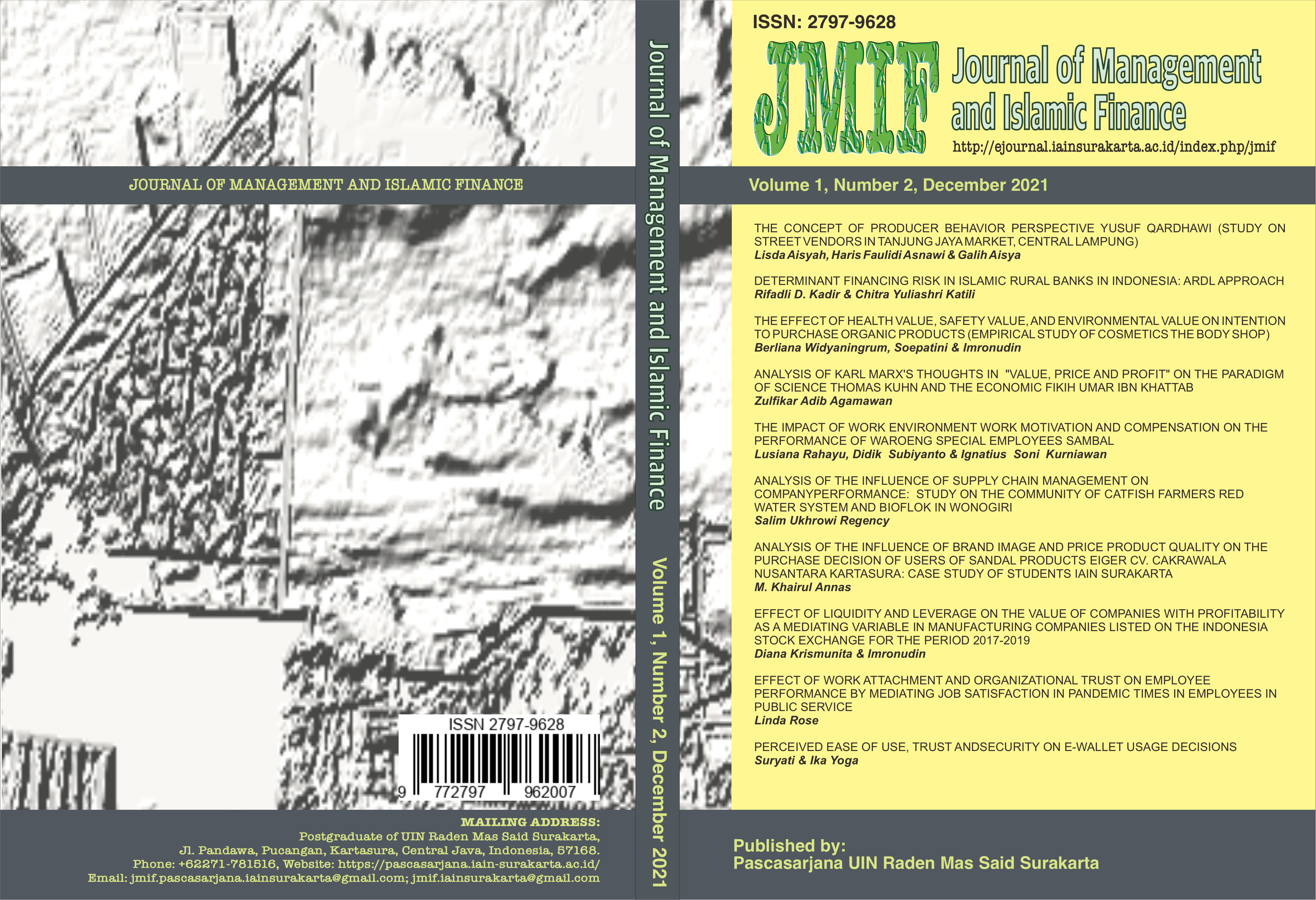THE INFLUENCE OF PERCEIVED EASE OF USE, TRUST AND SECURITY ON INTENTION TO USE E-WALLET
DOI:
https://doi.org/10.22515/jmif.v1i2.4692Keywords:
Perceived Ease of Use, Trust, Security, Intention to UseAbstract
Downloads
References
Adhi Prakosa, D. J. W. (2020). Analisis Faktor-Faktor Yang Mempengaruhi Minat Penggunaan Ulang E-Wallet Pada Generasi Milenial Di Daerah Istimewa Yogyakarta. Bulletin of the World Health Organization, 15(1), 50–53.
Aditya, R., & Wardhana, A. (2016). Pengaruh perceived usefulness dan perceived ease of use terhadap behavioral intention dengan pendekatan Technology Acceptance Model (TAM) pada pengguna Instant Messaging LINE di Indonesia. Jurnal Siasat Bisnis, 20(1), 24–32. https://doi.org/10.20885/jsb.vol20.iss1.art3
Alza, H. F., & Rikumahu, B. (2019). Analisis Faktor Risiko Sebagai Tambahan Dalam Model Tam Dalam Penggunaan Electronic Money (Studi Kasus: E-Money Mandiri Di Kota Jakarta). Journal of Chemical Information and Modeling, 3(2), 243–255.
Attar, R. W., Shanmugam, M., & Hajli, N. (2020). Investigating the antecedents of e-commerce satisfaction in social commerce context. British Food Journal. https://doi.org/10.1108/BFJ-08-2020-0755
Bagla, R. K., & Sancheti, V. (2018). Gaps in customer satisfaction with digital wallets: challenge for sustainability. Journal of Management Development, 37(6), 442–451. https://doi.org/10.1108/JMD-04-2017-0144
Fahmi, S. (2018). Pengaruh Persepsi Keamanan dan Kepercayaan terhadap Niat Konsumen dalam Melakukan Transaksi E-Commerce, melalui Sikap sebagai Variabel Intervening. JAMIN : Jurnal Aplikasi Manajemen Dan Inovasi Bisnis, 1(1), 86. https://doi.org/10.47201/jamin.v1i1.21
Hermawan, V. K., & Paramita, E. L. (2020). Trust dan Perceived Usefulness dan Pengaruhnya Terhadap Preferensi Konsumen Dalam Menggunakan E-wallet. Jurnal Ekobis : Ekonomi Bisnis & Manajemen, 10(2), 223–236. https://doi.org/10.37932/j.e.v10i2.131
Katon, F., & Yuniati, U. (2020). Fenomena Cashless Society Dalam Pandemi Covid-19 ( Kajian Interaksi Simbolik Pada Generasi Milenial ) Cashless Society Phenomenons in the Covid-19 Pandemy ( Study of Symbolic Interactions in Millennial Generation ). Signal, 8(2), 134–145.
Kumala, D. C., Pranata, J. W., & Thio, S. (2020). Pengaruh Perceived Usefulness, Perceived Ease of Use, Trust, Dan Security Terhadap Minat Penggunaan Gopay Pada Generasi X Di Surabaya. Jurnal Manajemen Perhotelan, 6(1), 19–29. https://doi.org/10.9744/jmp.6.1.19-29
Kustono, A. S., Nanggala, A. Y. A., & Mas’ud, I. (2020). Determinants of the Use of E-Wallet for Transaction Payment among College Students. Journal of Economics, Business, & Accountancy Ventura, 23(1), 85–95. https://doi.org/10.14414/jebav.v23i1.2245
Latief, F., & Dirwan, D. (2020). Pengaruh Kemudahan, Promosi, Dan Kemanfaatan Terhadap Keputusan Penggunaan Uang Digital. Jurnal Ilmiah Akuntansi Manajemen, 3(1), 16–30. https://doi.org/10.35326/jiam.v3i1.612
Musyaffi, A. M. (2019). Dampak Kemudahan dan Risiko Sistem Pembayaran QR Code : Technology Acceptance Model ( TAM ) Extension masyarakat yang tinggi atas penggunaan ( NFC ), dan One Time Password ( OTP ). dijelaskan melalui gambar 1 dibawah ini : 3(2), 161–176.
Namahoot, K. S., & Laohavichien, T. (2018). Assessing the intentions to use internet banking: The role of perceived risk and trust as mediating factors. International Journal of Bank Marketing, 36(2), 256–276. https://doi.org/10.1108/IJBM-11-2016-0159
Rahardjo, B., Khairul, I., & Siharis, A. K. (2019). Pengaruh Financial Technology (Fintech) Terhadap Perkembangan UMKM di Kota Magelang. Prosiding Seminar Nasional Dan Call For Papers, 347–356.
Rembulan, N. D. R., & Firmansyah, E. A. (2020). Perilaku Konsumen Muslim Generasi-Z Dalam Pengadopsian Dompet Digital. Valid Jurnal Ilmiah, 17(2), 111–128.
Saputri, O. B. (2020). Preferensi Konsumen Dalam Menggunakan Quick Response Code Indonesia Standard (QRIS) Sebagai Alat Pembayaran Digital. Journals of Economics and Business Mulawarman, 17(2), 237–247.
Sharma, S. K., & Sharma, M. (2019). Examining the role of trust and quality dimensions in the actual usage of mobile banking services: An empirical investigation. International Journal of Information Management, 44(September 2018), 65–75. https://doi.org/10.1016/j.ijinfomgt.2018.09.013
Shin, D. H. (2009). Towards an understanding of the consumer acceptance of mobile wallet. Computers in Human Behavior, 25(6), 1343–1354. https://doi.org/10.1016/j.chb.2009.06.001
Sifwatir Rif’ah. (2019). Fenomena Cashless Society Di Era Milenial Dalam Perspektif Islam. Al-Musthofa: Journal of Sharia Economic, 2(2), 1–121.
Sudjatmika, F. V. (2017). Pengaruh Harga, Ulasan Produk, Kemudahan, dan Keamanan Terhadap Keputusan Pembelian Secara Online di Tokopedia.com. Agora, 5(1), 1–7.
Tjokrosaputro, I. N. dan M. (2020). Pengaruh Perceived Usefulness, Perceived Ease Of Use Dan Trust Terhadap Intention To Use (Studi. II(3), 715–722.
Umaningsih, W. P., & Wardani, D. K. (2020). Pengaruh Persepsi Kemudahan, Fitur Layanan, Dan Keamanan Terhadap Niat Menggunakan E-Money. Jurnal Akutansi Dan Ekonomi, 5(21), 113–119. https://doi.org/10.29407/jae.v5i3.14057
Yadav, R., & Pathak, G. S. (2017). Determinants of Consumers’ Green Purchase Behavior in a Developing Nation: Applying and Extending the Theory of Planned Behavior. Ecological Economics, 134, 114–122. https://doi.org/10.1016/j.ecolecon.2016.12.019
Yuliani Dwi Rahmawati1, R. Y. (2020). Pengaruh Persepsi Manfaat, Persepsi Kemudahan, Dan Persepsi Keamanan Terhadap Keputusan Penggunaan E-Wallet Pada Mahasiswa Stie Bank Bpd Jateng. Journal of Economics and Banking, 2(2), 157–168.
Zhang, T., Lu, C., & Kizildag, M. (2018). Banking “on-the-go”: examining consumers’ adoption of mobile banking services. International Journal of Quality and Service Sciences, 10(3), 279–295. https://doi.org/10.1108/IJQSS-07-2017-0067
Downloads
Published
Issue
Section
Citation Check
License
Copyright (c) 2022 Suryati Suryati, Ika Yoga

This work is licensed under a Creative Commons Attribution-ShareAlike 4.0 International License.
Authors who publish with this journal agree to the following terms:
- Authors retain copyright and grant the journal right of first publication with the work simultaneously licensed under a Creative Commons Attribution License that allows others to share the work with an acknowledgement of the work's authorship and initial publication in this journal.
- Authors are able to enter into separate, additional contractual arrangements for the non-exclusive distribution of the journal's published version of the work (e.g., post it to an institutional repository or publish it in a book), with an acknowledgement of its initial publication in this journal.
- Authors are permitted and encouraged to post their work online (e.g., in institutional repositories or on their website) prior to and during the submission process, as it can lead to productive exchanges, as well as earlier and greater citation of published work.






